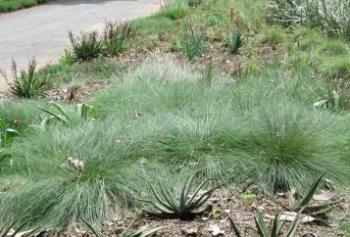Harpochloa falx
Harpochloa falx (L.f.) Kuntze
Family: Poaceae
Common names: caterpillar grass (Eng.), ruspergras (Afr.)
Introduction
The caterpillar grass, Harpochloa falx, is a wonderful garden plant, which forms neat, dark green tussocks which persist throughout the year and produce unusual 'toothbrush' flowers in summer. This species, in common with a number of other indigenous tufted grasses, provides a perfect foil for many South African plants such as aloes, agapanthus and red hot pokers.

Description
Description
Caterpillar grass is a densely tufted perennial, growing in tussock-like form to about half a metre in height. The leaves are dark green, coarse, narrow, and often in-rolled. They remain green throughout the year in frost-free conditions. From September to April the one-sided, sickle-shaped 'flowers' are produced on stalks about 750 mm long.

Distribution and habitat
Distribution description
The species only occurs in Eastern Cape, KwaZulu-Natal, Lesotho, Gauteng and Mpumalanga, usually in areas with a high rainfall. It is common in the cool grasslands.
Derivation of name and historical aspects
History
The botanical name is derived from the interesting shape of the inflorescence harpo means 'hook-like' and falx is the Latin word for 'sickle'. The common name caterpillar grass also refers to the flower shape.
Ecology
Ecology
Caterpillar grass is usually found in undisturbed, mountainous grassland, on stony slopes in well-drained soil. In these areas it is common, often forming dense stands. It withstands close grazing and trampling better than other climax species such as rooigras (Themeda triandra). As with most grasses. Harpochloa falx is wind-pollinated, and copious amounts of pollen are produced by the exposed anthers and carried by air currents to the feathery stigmas.

Uses
Use
The toothbrush-like inflorescences are sometimes used in flower arrangements. This grass is highly palatable to livestock and game.
Growing Harpochloa falx
Grow
Ripe seed collected in the summer (November to January) germinates easily in seed trays. Young plants can be planted out in spring (or earlier in frost-free areas).
Alternatively, some nurseries sell young plants as 'plugs', which can be planted directly into prepared ground and kept watered until established. Thereafter, little attention is needed, other than cutting back leaf mass at the end of winter. Once established, the plants need very little water and do not appear to be susceptible to disease or pests. (In spite of its common name it is not eaten by caterpillars!)
Harpochloa falx, with its rounded form, can either be grown individually as 'specimen' plants, or grouped close together (30cm spacing) to provide structure within a garden. The clumps of grass are particularly striking when interspersed with plants of contrasting growth form.
An effective planting in the Natal National Botanical Garden consists of groups of caterpillar grass inter-planted with the blue squill, Merwilla plumbea.
References
- GIBBS-RUSSELL, G.E., WATSON, L., KOEKEMOER, M., SMOOK, L., BARKER, N., ANDERSON, H.M. & DALLWITZ, M.J. 1990. Grasses of southern Africa. Memoirs of the Botanical Survey of South Africa No.58.
- VAN WYK, E. & VAN OUTDTSHOORN, F. 1999. Guide to grasses of southern Africa. Briza Publications, Pretoria.
Credits
Isabel Johnson
Natal National Botanical Garden
January 2003
Plant Attributes:
Plant Type: Grass
SA Distribution: Eastern Cape, Free State, Gauteng, KwaZulu-Natal, Limpopo, Mpumalanga, North West, Western Cape
Soil type:
Flowering season:
PH:
Flower colour:
Aspect:
Gardening skill:
Special Features:
Horticultural zones










Rate this article
Article well written and informative
Rate this plant
Is this an interesting plant?
Login to add your Comment
Back to topNot registered yet? Click here to register.